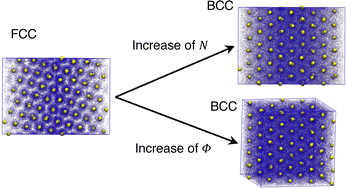Impact of free energy of polymers on polymorphism of polymer-grafted nanoparticles†
Abstract
Colloidal crystals have gathered wide attention as a model material for optical applications because of their feasibility in controlling the propagation of light by their crystal structure and lattice spacing as well as the simplicity of their fabrication. However, due to the simple interaction between colloids, the colloidal crystal structures that can be formed are limited. It is also difficult to adjust the lattice spacing. Furthermore, colloidal crystals are fragile compared to other crystals. In this study, we focused on polymer-grafted nanoparticles (PGNP) as a possible solution to these unresolved issues. We expected that PGNPs, composed of two distinct layers (the hard core of a nanoparticle and the soft corona of grafted polymers on the surface), will demonstrate similar behaviors as star polymers and hard spheres. We also predicted that PGNPs may exhibit polymorphism because the interaction between PGNPs strongly depends upon their grafting density and the length of the grafted polymer chains. Moreover, we expected that crystals made from PGNPs will be structurally tough due to the entanglement of grafted polymers. From exploration of crystal polymorphs of PGNPs by molecular dynamics simulations, we found face-centered cubic (FCC)/hexagonal close-packed (HCP) and body-centered cubic (BCC) crystals, depending on the length of the grafted polymer chains. When the chains were short, PGNPs behaved like hard spheres and crystals were arranged in FCC/HCP structure, much like the phase transition observed in an Alder transition. When the chains were long enough, the increase in the free energy of grafted polymers was no longer negligible and crystals were arranged in BCC structure, which has a lower density than FCC/HCP. When the chains were not too short or long, FCC/HCP structures were first observed when the volume fraction of system was small, but a phase transition occurred when the system was further compressed and the crystals arranged themselves in a BCC structure. These results most likely have laid strong foundations for future simulations and experimental studies of PGNP crystals.



 Please wait while we load your content...
Please wait while we load your content...